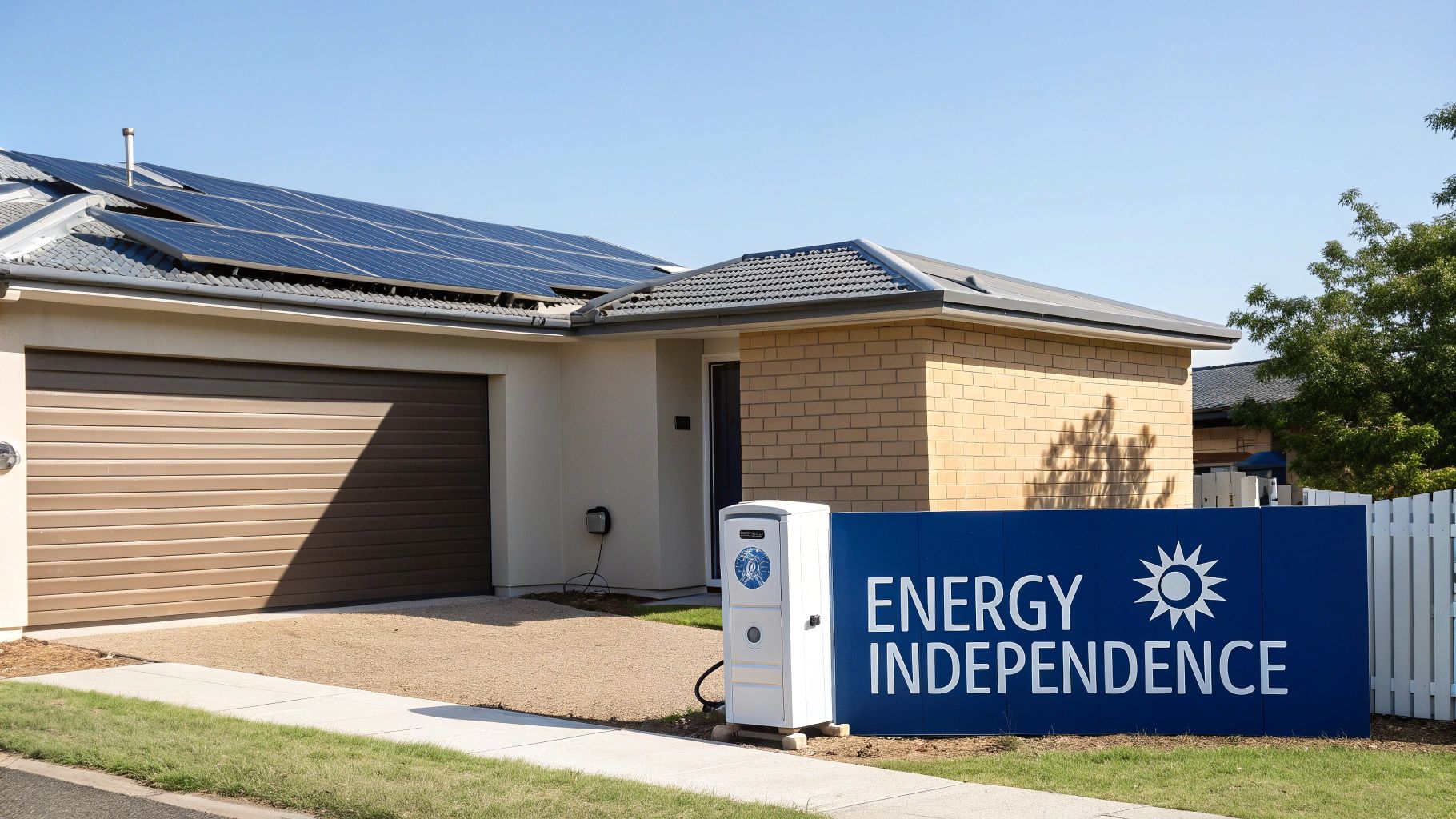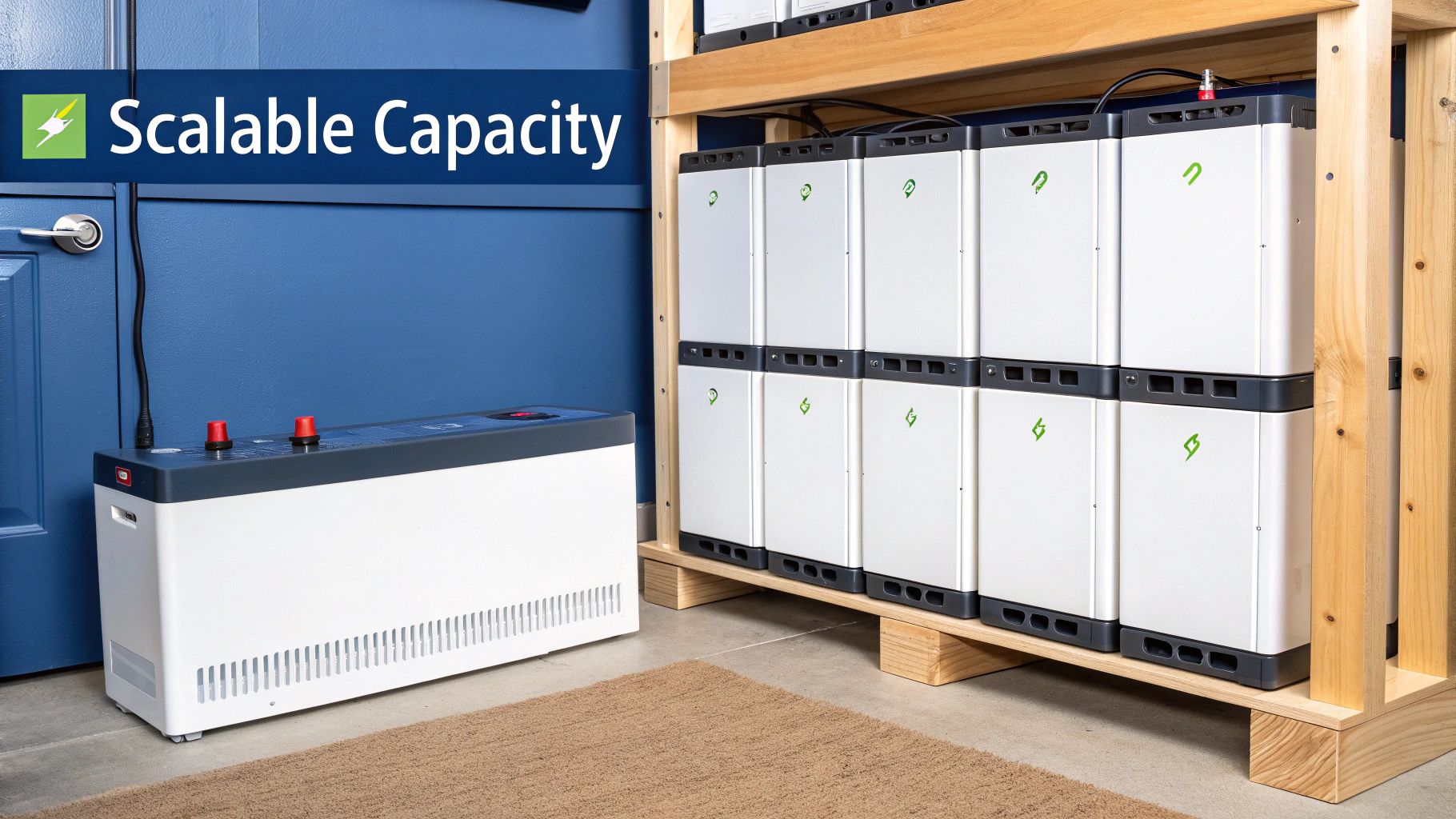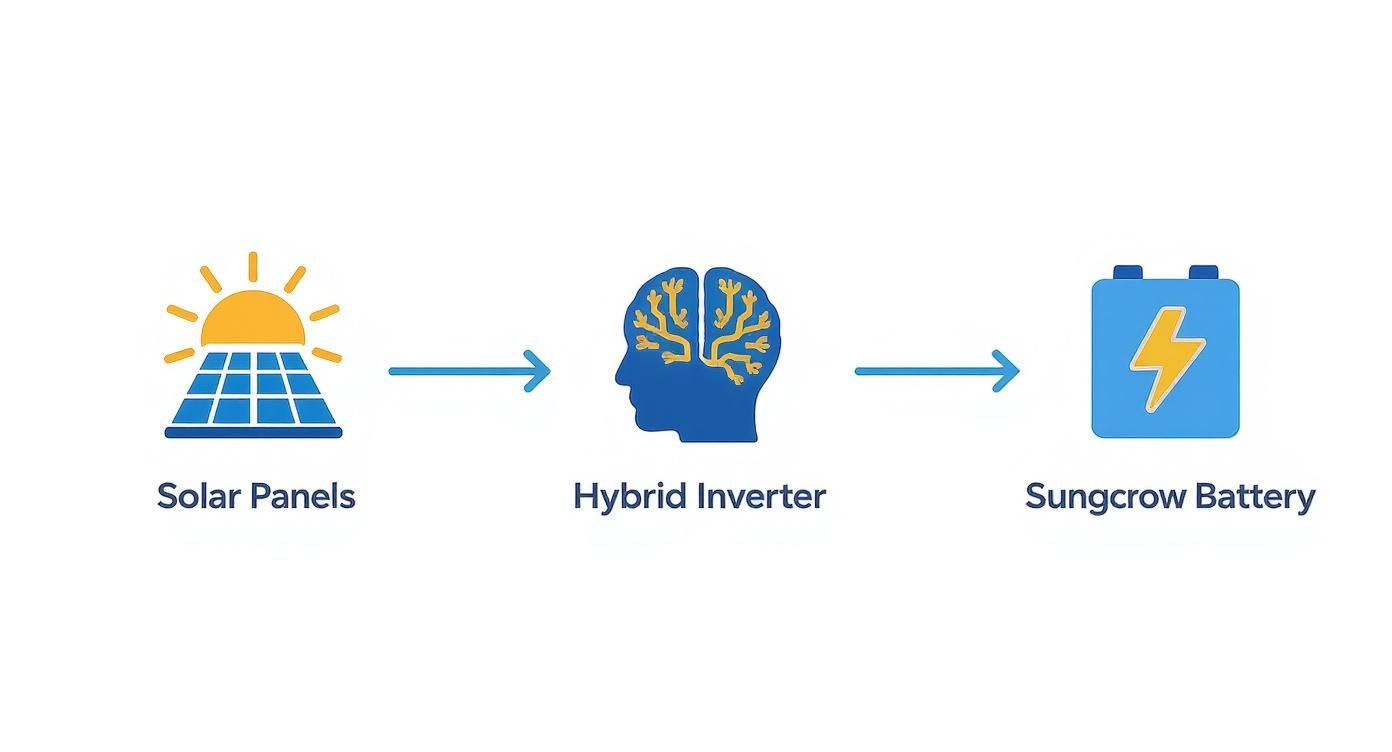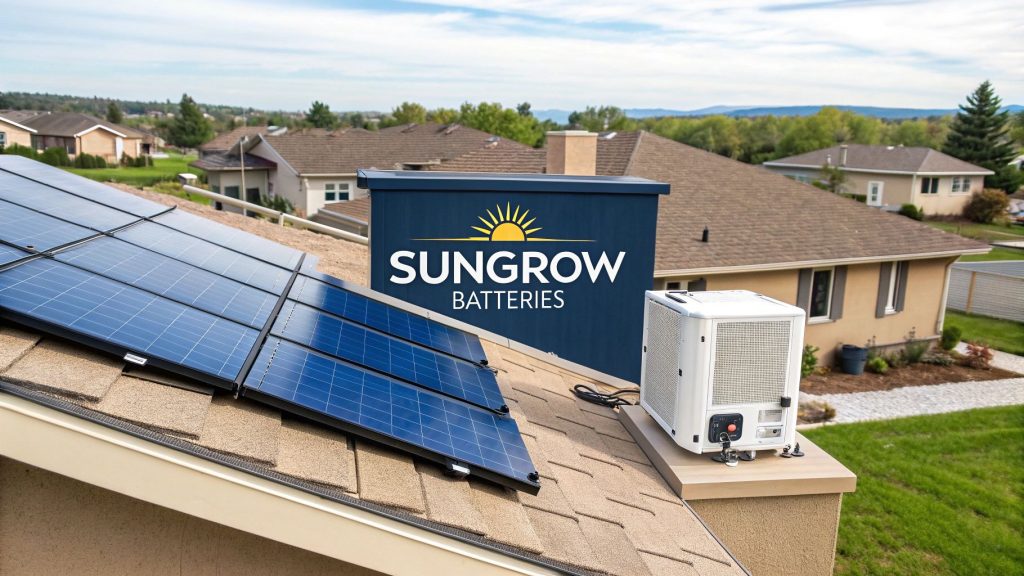A Homeowner’s Guide to Sungrow Batteries
Sungrow batteries are fast becoming the go-to choice for Australian homeowners wanting to do more with their solar. It's about storing that clean energy you generate, cutting your power bills, and having the lights stay on when the grid goes down. These systems are known for being tough, reliable, and cleverly designed to grow with your needs.
Why Sungrow Is a Top Choice for Australian Homes

For a lot of us, putting panels on the roof was just the beginning. The real game-changer is being able to use that free solar energy long after the sun has set. That's exactly where a Sungrow battery fits in. Think of it as your personal energy bank, one that completely rewires how you power your home.
Instead of sending your valuable excess solar back to the grid for a pittance, a Sungrow battery squirrels it away for later. When the evening peak hits and grid prices soar, you’re running your home on your own stored solar. This simple shift dramatically cuts your reliance on expensive grid power and takes a serious chunk out of your electricity bills.
Proven Performance in the Australian Market
Sungrow’s reputation wasn't built overnight. It’s been earned through years of solid performance in Aussie conditions, backing up both homeowners and installers with quality products and real, local support. This track record is a huge reason why so many people trust Sungrow when they decide to add storage to their homes.
This isn’t just talk, either. The numbers back it up. Recent data shows Sungrow is the No.1 Inverter and Residential Battery Manufacturer in Australia. With over 400,000 systems installed in the 12 years they’ve been in the local market, it's clear that homeowners have a huge amount of confidence in their tech. You can check out the latest rankings and get more details on Sungrow's market position in Australia.
By storing your own solar power, you gain greater control over your energy costs and a reliable backup source during blackouts, providing true peace of mind.
What This Guide Covers
This guide is designed to give you a complete picture of what makes a Sungrow battery such a smart move. We’ll walk you through:
- The Different Models: A simple breakdown of the SBR series and its clever, stackable design.
- Maximising Your Investment: How the battery and inverter work as a team to help you use more of your own solar power.
- Earning Extra Income: How you can join a Virtual Power Plant (VPP) with platforms like HighFlow Connect and get paid.
- Sizing and Savings: Figuring out the right system for your home and what the payback looks like.
Getting to Know the Sungrow SBR Battery Models

When you start digging into Sungrow batteries for your home, the SBR series is the name you'll see everywhere. This is Sungrow’s main residential battery, and its design is both smart and incredibly practical for Aussie homeowners.
The whole idea behind the SBR series is modularity. Think of it like building with Lego blocks. You don’t have to guess your future energy needs and commit to a massive, expensive battery right away. Instead, you can start with a system that fits your home and budget today, knowing you can easily add more storage later on if things change.
This approach makes getting into home energy storage a lot less daunting. You can begin with a single stack of battery modules and expand it when your family grows, you finally buy that EV, or you just decide you want more blackout protection.
The Building Blocks of Your Energy Storage
The SBR system is built from individual 3.2kWh battery modules. A minimum of three modules are stacked together to form the smallest functional battery, giving you 9.6kWh of total storage. From there, it's a simple case of adding more modules to get the capacity you need.
- Start Small: A 9.6kWh system is a really common starting point for average-sized Australian homes.
- Expand Later: You can stack up to eight modules together, taking a single unit all the way to 25.6kWh.
- Go Big: For homes with seriously high energy demands, you can connect up to four of these stacks in parallel for a massive 102.4kWh of storage.
This flexibility means your investment in a Sungrow battery is future-proof. It adapts to your life, rather than forcing you to predict it years in advance.
The modular design of the Sungrow SBR series means you buy what you need now and can easily scale up later. It’s a smarter way to invest in your home's energy future without overcommitting upfront.
What the Specs Actually Mean
Technical specs can look like a foreign language, but they tell an important story about how a battery will perform in the real world. A key feature of the Sungrow SBR is its use of Lithium Iron Phosphate (LFP) chemistry. This is widely seen as one of the safest and most durable battery technologies for home use, offering a longer lifespan and better stability in the heat than other lithium-ion types. It’s a great fit for Australian conditions.
Another number that matters is the power output. A higher output means the battery can run more appliances at once. Sungrow SBR batteries have strong power ratings, so during a blackout, you can keep essentials like the fridge, lights, and even the kettle running without the system breaking a sweat. For a deep dive into what a popular Sungrow SBR 096 system can do for your home, you can check out the full specifications.
To help you picture how the different sizes stack up, here’s a quick comparison.
Sungrow SBR Battery Models at a Glance
This table breaks down the most common Sungrow SBR configurations available in Australia, helping you match a battery size to your household's energy habits.
| Model (Configuration) | Total Capacity (kWh) | Usable Capacity (kWh) | Peak Power Output | Ideal for Household Size |
|---|---|---|---|---|
| SBR096 (3 modules) | 9.6 kWh | 9.6 kWh | 6.0 kW | Small to average family homes |
| SBR128 (4 modules) | 12.8 kWh | 12.8 kWh | 8.0 kW | Average families with higher usage |
| SBR160 (5 modules) | 16.0 kWh | 16.0 kWh | 10.0 kW | Large families or small businesses |
| SBR192 (6 modules) | 19.2 kWh | 19.2 kWh | 12.0 kW | Homes with EVs and high energy needs |
As you can see, the modular system lets you dial in the right balance of storage capacity and power output, whether you're just starting to offset your bills or aiming for near-complete energy independence.
How a Sungrow Battery Turns Your Solar Into a 24/7 Power Source
Without a battery, your solar panels are like a fair-weather friend—they're brilliant when the sun's out, but disappear after dark. A Sungrow battery system changes that relationship entirely. It turns your rooftop solar from a daytime-only asset into a round-the-clock energy solution that works for you, day and night.
Think of your Sungrow battery as your personal energy bank. In the middle of the day, your panels are often making more power than your home can use. Instead of sending that surplus back to the grid for a pittance, the battery stores it. It’s like putting money in the bank for a rainy day, only this is clean energy for a cloudy one.
Then, as the sun goes down and your solar production fades, your home automatically starts drawing from that stored, free energy. You're no longer forced to buy expensive electricity from the grid during the evening peak. This simple cycle of storing and using your own power is called self-consumption, and it’s the cornerstone of slashing your power bills.
The Brains of the Operation
The hero in all this is the Sungrow hybrid inverter. It's the intelligent 'brain' of your home energy system, constantly making smart decisions about where your solar energy needs to go, moment by moment.
- First, power your home: It always prioritises sending solar energy directly to your lights and appliances.
- Then, charge the battery: Once your home’s needs are met, it funnels the excess energy into your Sungrow battery.
- Finally, export to the grid: Only when your home is powered and your battery is full does it send any leftover energy to the grid.
This intelligent energy management is the key. The hybrid inverter and battery work in perfect sync to make sure you use as much of your own solar power as possible, which is what drastically cuts your reliance on the grid.
Taking Back Control
This shift to self-consumption does more than just save you money. It gives you a real sense of energy independence. You're no longer just a passive customer, subject to the whims of fluctuating grid prices and the risk of power outages. You're actively managing your own clean energy supply.
For a lot of Australian homeowners, that’s the real prize. Maximising your solar investment isn't just about the panels; it's about taking control of the energy you generate. A Sungrow battery system gives you the tools to do just that, ensuring the clean power you produce during the day is still working hard for you long after the sun has set.
Earning Extra Income with Virtual Power Plants
Your Sungrow battery is more than just a way to cut your power bills. It can also be an active asset, earning you an income. This is done through a clever grid-support program called a Virtual Power Plant, or a VPP. A VPP takes your battery from being a passive storage tank and turns it into an active player in the energy market.
Think of a VPP as a neighbourhood watch for the power grid, made up of home batteries working as a team. When the main grid is under strain—like on a scorching summer afternoon when every air conditioner in the state kicks in—it needs more power, and fast. A VPP pools the stored energy from hundreds or thousands of home batteries, including yours, and sells it back to the grid when prices are at a premium.
This process helps keep the grid stable for everyone and cuts our reliance on expensive, dirty "peaker" power plants. In return for letting the VPP use a slice of your stored energy, you get paid. Your battery starts generating revenue.
This diagram shows how solar energy flows through your system, ready to be stored and used when you need it most.

As the infographic shows, the hybrid inverter is the brains of the operation. It intelligently sends power from your solar panels to run your home, charge your Sungrow battery, or export to the grid.
How HighFlow Connect Makes It Simple
Joining a VPP might sound complicated, but platforms like HighFlow Connect are designed to make it a completely seamless process for Sungrow battery owners. HighFlow Connect acts as the coordinator, managing your battery’s participation without you having to lift a finger.
The system automatically spots high-price events on the grid and coordinates the discharge of your stored energy to maximise what you earn. Crucially, you stay in complete control of your system. You set a minimum backup reserve, so you’ve always got power tucked away for a blackout. This approach gives you the best of both worlds: blackout protection and a way to generate income.
By participating in a VPP, you transform your Sungrow battery from a cost-saving device into an income-earning asset. It’s a powerful way to accelerate your return on investment while supporting a cleaner, more resilient energy grid.
The financial benefits can be quite significant. Participants often see extra credits appear on their power bills, effectively getting paid to help the grid. This changes the economics of owning Sungrow batteries, adding a compelling new layer of value on top of the daily energy savings.
To explore how you can enrol your system, you can find more information about the Sungrow VPP program with HighFlow Connect and start earning from your investment.
Choosing the Right System Size and Calculating Savings
Figuring out the right size for your Sungrow battery isn’t about just grabbing the biggest one you can find. It’s more of a balancing act between your family’s power habits, how big your solar system is, and what you’re trying to achieve. Get this right, and you’re on the path to making your investment work hard for you.
The goal is to hit the sweet spot. A battery that’s too small will have you buying expensive power from the grid every night. But one that's too big means you've paid for storage capacity you’ll rarely touch. The trick is to match your battery to both your daily power use and what your panels can generate.
Sizing Your Sungrow Battery Correctly
First, pull out your recent power bills. You’re looking for your average daily energy consumption, measured in kilowatt-hours (kWh). This figure is your starting point—it tells you how much electricity your home typically chews through in 24 hours, especially after the sun goes down.
Next, have a look at your solar array. It makes sense that a bigger solar system, say 10kW, will generate far more spare energy to fill a large battery than a smaller 5kW system. A good rule of thumb is to aim for enough battery capacity to soak up most of your excess solar generation on a good, sunny day.
Finally, what’s your main reason for getting a battery?
- Maximum Bill Reduction: If you just want to shrink your power bills, a battery that covers your usual evening and overnight usage is often the perfect fit. For many average Australian homes, a popular 9.6kWh Sungrow SBR unit is a fantastic place to start.
- Blackout Protection: If you’re more concerned about riding out power cuts, you’ll want a bigger battery. This gives you a larger energy reserve to keep not just the basics, but more of your home running for longer.
Calculating Your Potential Savings
Once you've got a handle on sizing, you can start to see how the numbers stack up. The savings from a Sungrow battery come from a few different places, turning it from a simple appliance into a hard-working financial asset for your home.
The most obvious saving is from increased self-consumption. You’re storing your own free solar power instead of selling it back for a tiny feed-in tariff, which means you don't have to buy expensive electricity from the grid at night. For many households, this alone can slash the import part of their bill by 80-90% or even more.
Your return on investment comes down to a simple formula: the value of the grid electricity you no longer have to buy, plus any extra income you can earn from your stored power.
On top of that, joining a Virtual Power Plant (VPP) through a platform like HighFlow Connect opens up another way to earn. By letting the VPP sell some of your stored energy to the grid during peak demand events, you can earn extra credits on your bill and speed up the payback time on your system.
The boom in home batteries across Australia is also being helped along by various government programs. Schemes like the Cheaper Home Batteries Program are fuelling this growth, with over 43,517 new solar battery installations logged since July 1, 2025, in some states alone. You can read more about how government incentives are boosting battery adoption. These kinds of rebates can take a serious chunk out of the upfront cost, making the financial case for a Sungrow battery even more compelling.
What to Expect from Installation, Warranty and Support
A home battery is a serious investment in your energy freedom. You need to know it’s backed by solid installation standards, a proper warranty, and local support you can actually reach. Peace of mind is non-negotiable.
Installing a Sungrow battery is a straightforward job for a qualified professional. A certified installer will usually mount the battery modules and the brains of the operation—the Battery Management Unit (BMU)—on a suitable wall, often near your inverter. They’ll handle all the wiring and commission the system to make sure it’s talking perfectly with your solar setup. It's absolutely critical this work is done by a Clean Energy Council (CEC) accredited installer to guarantee safety and compliance.
Understanding Your Sungrow Warranty
Sungrow backs its residential SBR batteries with a strong 10-year product and performance warranty, which is the mark of quality in the Australian market. This warranty gives you two layers of protection, so you can be confident in your system's longevity.
- Product Warranty: This covers you for defects in materials or workmanship. If a part fails within the 10-year window because of a manufacturing fault, Sungrow will repair or replace it. Simple as that.
- Performance Warranty: This is the big one. It guarantees your battery will hold a certain amount of its storage capacity over its lifespan. Sungrow ensures its batteries will retain at least 70% of their original usable capacity after 10 years of doing their job.
This dual coverage means you’re not just protected against immediate faults, but you also have a guarantee that your battery will still be a workhorse a decade down the track. Knowing how long solar batteries last is key, and this warranty gives you a clear benchmark for your investment.
The Value of Local Australian Support
Having strong local support is a massive advantage when you really need it. While Sungrow has cemented its spot as a top residential battery brand in Australia, the market is fierce, with others like AlphaESS and GoodWe also putting in a strong showing. A key reason for Sungrow’s staying power is its established Australian service network and solid partnerships, which means reliable, local help is always on hand. You can read more about what it takes to lead the competitive Australian battery market on SunWiz.com.au.
This local presence is what makes the difference. If an issue ever pops up, you or your installer can get fast, expert assistance from someone who understands Australian conditions.
Got questions about Sungrow batteries? You're not alone. Here are the straight-up answers to the most common things Australian homeowners want to know before making the switch.
Can a Sungrow Battery Work with My Existing Solar Panels?
Yes, almost certainly. Sungrow batteries are designed to play nice with existing solar PV systems. It's a process called 'AC coupling', and a good installer can easily retrofit one to your current setup using a compatible Sungrow inverter.
They'll take a quick look at what you've got on the roof and recommend the best way to integrate the battery. Before you know it, you'll be storing your own solar power instead of sending it all back to the grid for pennies.
How Long Does a Sungrow Battery Last During a Blackout?
That really depends on three things: the size of your battery, what you’re running in the house, and how much juice was in it when the grid went down.
To give you a rough idea, a fully charged 9.6kWh Sungrow SBR battery could easily keep the essentials running – think fridge, lights, and the all-important internet router – for several hours, or even through the night if you're mindful of your usage.
Pro Tip: Use the monitoring app to set a backup reserve. This tells the system to always keep a certain percentage of the battery's charge—say, 30%—aside just for blackouts. It’s your guaranteed peace of mind.
What Maintenance Is Required for the Battery?
Honestly, pretty much none. Sungrow batteries are a sealed unit, built to be a set-and-forget piece of kit. There are no parts inside for you to service.
The system's health is all monitored remotely through the iSolarCloud app. If it ever detects an issue, it will automatically flag it for you and your installer. You just get on with your life.
Ready to take back control of your power bills and see what a Sungrow battery could do for your home? Explore your options with HighFlow Connect. We can show you how to start saving more and even earn extra from your solar setup. Learn more at https://highflowconnect.com.au.


